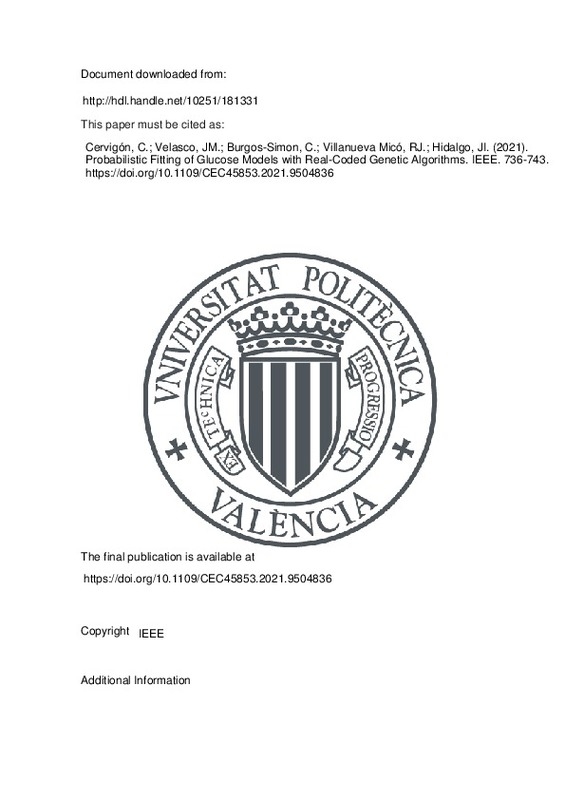Cervigón, C.; Velasco, JM.; Burgos-Simon, C.; Villanueva Micó, RJ.; Hidalgo, JI. (2021). Probabilistic Fitting of Glucose Models with Real-Coded Genetic Algorithms. IEEE. 736-743. https://doi.org/10.1109/CEC45853.2021.9504836
Por favor, use este identificador para citar o enlazar este ítem: http://hdl.handle.net/10251/181331
|
Título:
|
Probabilistic Fitting of Glucose Models with Real-Coded Genetic Algorithms
|
|
Autor:
|
Cervigón, Carlos
Velasco, J. Manuel

 Burgos-Simon, Clara
Burgos-Simon, Clara

 Villanueva Micó, Rafael Jacinto
Hidalgo, J. Ignacio
Villanueva Micó, Rafael Jacinto
Hidalgo, J. Ignacio
|
|
Fecha difusión:
|
|
|
Resumen:
|
[EN] Type 1 Diabetes patients have to control their blood
glucose levels using insulin therapy. Numerous factors (such as
carbohydrate intake, physical activity, time of day, etc.) greatly
complicate this task. In this ...[+]
[EN] Type 1 Diabetes patients have to control their blood
glucose levels using insulin therapy. Numerous factors (such as
carbohydrate intake, physical activity, time of day, etc.) greatly
complicate this task. In this article we propose a modeling method
that will allow us to make predictions of blood glucose level
evolution with a time horizon of 24 hours. This may allow the
adjustment of insulin doses in advance and could help to improve
the living conditions of diabetes patients. Our approach starts
from a system of finite difference equations that characterizes
the interaction between insulin and glucose (in the field, this is
known as a minimal model). This model has several parameters
whose values vary widely depending on patient characteristics
and time. Thus, in the first phase of our strategy, We will enrich
the patient¿s historical data by adding white Gaussian noise,
which will allow us to perform a probabilistic fitting with a 95%
confidence interval. Then, the model¿s parameters are adjusted
based on the history of each patient using a genetic algorithm and
dividing the day into 12 time intervals. In the final stage, we will
perform a whole-day forecast from an ensemble of the models
fitted in the previous phase. Th e validity of our strategy will be
tested using the Parkers¿ error grid analysis. Our experimental
results based on data from real diabetic patients show that this
technique is capable of robust predictions that take into account
all the uncertainty associated with the interaction between insulin
and glucose.
[-]
|
|
Palabras clave:
|
Diabetes
,
Glucose prediction
,
Genetic algorithms
,
Evolutionary computation
|
|
Derechos de uso:
|
Reserva de todos los derechos
|
|
ISBN:
|
978-1-7281-8393-0
|
|
Fuente:
|
Proceedings of the IEEE Congress on Evolutionary Computation, CEC 2021, Krakow, Poland, June 28 - July 1, 2021.
|
|
DOI:
|
10.1109/CEC45853.2021.9504836
|
|
Editorial:
|
IEEE
|
|
Versión del editor:
|
https://doi.org/10.1109/CEC45853.2021.9504836
|
|
Título del congreso:
|
IEEE Congress on Evolutionary Computation (CEC 2021)
|
|
Lugar del congreso:
|
Online
|
|
Fecha congreso:
|
Junio 28-Julio 01,2021
|
|
Código del Proyecto:
|
info:eu-repo/grantAgreement/AEI/Plan Estatal de Investigación Científica y Técnica y de Innovación 2017-2020/RTI2018-095180-B-I00/ES/SISTEMA ADAPTATIVO BIOINSPIRADO PARA EL CONTROL GLUCEMICO BASADO EN SENSORES Y ACCESORIOS INTELIGENTES/
info:eu-repo/grantAgreement/CAM//Y2018%2FNMT-4668//Micro-Stres-MAP-CM /
info:eu-repo/grantAgreement/CAM//S2017%2FBMD-3773//GenObIA-CM/
|
|
Agradecimientos:
|
We acknowledge support from Spanish Ministry of Economy and Competitiveness under project RTI2018-095180-
B-I00 and Madrid Regional Goverment - FEDER grants B2017/BMD3773 (GenObIA-CM) and Y2018/NMT-4668
(Micro-Stress- ...[+]
We acknowledge support from Spanish Ministry of Economy and Competitiveness under project RTI2018-095180-
B-I00 and Madrid Regional Goverment - FEDER grants B2017/BMD3773 (GenObIA-CM) and Y2018/NMT-4668
(Micro-Stress- MAP-CM). Devices for adquiring data from
patients were adquired with the support of Fundacion Eugenio Rodriguez Pascual 2019 grant - Desarrollo de sistemas adaptativos y bioinspirados para el control glucemico con infusores subcutaneos continuos de insulina y monitores continuos de
glucosa (Development of adaptive and bioinspired systems
for glycaemic control with continuous subcutaneous insulin
infusors and continuous glucose monitors).
[-]
|
|
Tipo:
|
Comunicación en congreso
Capítulo de libro
|







![[Cerrado]](/themes/UPV/images/candado.png)


